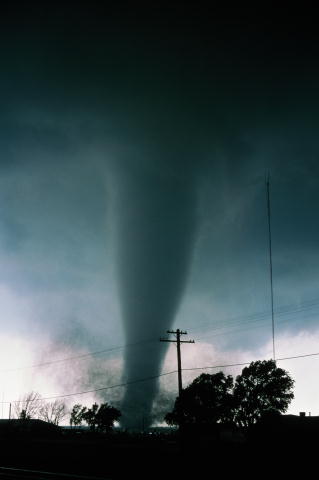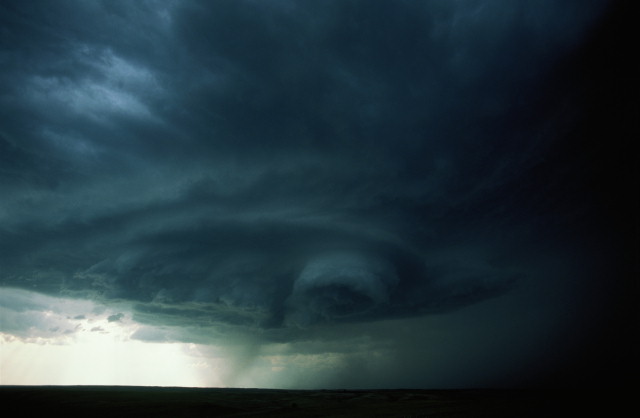A strong wind blows the roof off the houses, destroys small buildings, dangerous objects fly in the air - all this creates enormous destruction, which in turn causes a huge number of victims.
How do typhoons and tornadoes form?
A tornado is formed in a warm sea and moist wind in one of two relatively narrow belts located north and south of the equator. North America suffers from hurricanes that form in the Atlantic Ocean. Having gained tremendous strength in a few days, the tornado goes to the western part to the Caribbean Sea, then turns north. But the hurricane, which formed in the west of Mexico, is less dangerous. They go across the Pacific Ocean and almost never touch land. And a typhoon that originated in the western Pacific is very destructive. It goes towards Japan, the Philippines and Asia. Also, do not forget about the Indian Ocean, which creates tropical cyclones.
Why do hurricanes form
Scientists cannot yet explain why some hurricanes are strong and bring so much trouble, while others do not acquire such great power. But the main factor of their appearance is excessive humidity and heat. Usually storms and storms begin at the end of summer. At this time, the water is heated to 25-28 degrees and the humidity is very high.
It all starts with the formation of small areas of low pressure above the surface of the southern seas, where warm, moist air begins to rise rapidly. There is a condensation of several tons of water vapor with the release of a huge amount of heat, which gives an additional impetus to the ascending air currents. And soon the whirlwind of moist winds around "eyes of the storm" .
A tornado originates over the land of the earth. They can form anywhere and anytime. But usually they rage in Central America - from Kansas and Oklahoma to Texas. Why is the US the most hit by hurricanes? It is here that moisture condensate and heat.
The most destructive hurricanes and typhoons in the history of mankind
 "Irene" On August 27, 2011, the American state of North Carolina was hit by this tornado. Category - 3. Then I walked through other countries: Cuba, Haiti, and affected almost the entire East Coast of the United States.
"Irene" On August 27, 2011, the American state of North Carolina was hit by this tornado. Category - 3. Then I walked through other countries: Cuba, Haiti, and affected almost the entire East Coast of the United States.
October 30 typhoon "Parma" raged on the island of Lusoi (Philippines). Category - 4. 465 people died.
Late September 2009, strong typhoon "Ketsana" walked through the territory of China, the Philippines, Laos, Vietnam, Thailand, Cambodia. Typhoon speed - up to 167 km / h. In Vietnam, 16 people died, 170,000 houses were destroyed. Philippines - 464 people died, 2.5 million people were affected by this typhoon. Laos - 16 people, Cambodia - 17 people.
Late August early September 2008 strong hurricanes in Cuba "Ike" and "Gustav" destroyed a huge number of houses up to 100,000. 4 people died. It was the most powerful hurricane in 60 years in Cuba.
Night of May 3, 2008 tropical cyclone "Narenz inflicted a devastating force on Myanmar. The cyclone formed a huge flood that flooded a large area of the area. 138,000 people died.
August 23-30, 2005 "Katrina" the most destructive hurricane in American history. Completely destroyed the city of New Orleans in Louisiana. 1836 people died.
October 1998 Central America hurricane "Mitch" destroyed cities and towns. 11,000 people died.
September 19-20, 1974, a terrible natural disaster that occurred on the territory of the Republic of Honduras. Hurricane with wind force up to 200 km/h "Fifi", superfast and destructive, with powerful downpours. Destroyed and flooded almost everything. 10,000 people died.
On the night of November 13, 1970, a typhoon in East Pakistan formed a huge wave up to 8 meters, which hit the coast of Pakistan. This is one of the largest and most destructive disasters in history. How many victims were not established, approximately from 500,000 to 1 million people. Cities and villages were destroyed.
Hurricane scale
In 1970, Herbert Saffira and Robert Simpson developed a scale for categorizing hurricanes. Category 1 to 5, minimal to catastrophic.
In 1806, English Admiral Francis Beaufort proposed a scale for measuring wind. From 0 calm to 12 hurricane.

Hurricanes in Russia
In June 1983, there was a strong tornado in Anapa that passed through the city. The tornado did not destroy the entire city; it zigzagged as it were. Slate was torn off the roofs of houses, trees were uprooted (the tree was about a meter in diameter, the height of a three-four-story building). Heavy rain poured down, flooding the city and nearby settlements. There was a strong storm at sea, from which the embankment suffered. In the Varvarovskaya gap (this is between the village of Varvarovka and the village of Sukko), a car was blown into the sea, in which there were 2 people. People died. I can’t say for sure whether I sewed a car with people or not.
In 1984, a hurricane of the strongest force was in central Russia. At this time, the wind force reached up to 27 m/s.
On the night of June 20-21, 1998, a hurricane raged in Moscow. 8 people died. The wind force was up to 31 m/s.
On October 8, 2003, a hurricane raged in the central part of Russia; a bus with people overturned in the Tula region, 4 people died.
On July 16, 2004, in the Irkutsk region and the Ust-Buryat Autonomous Okrug, 6 people died from a strong wind.
January 6, 2005 in St. Petersburg was a strong wind with heavy rain. The water in the reservoirs rose by two meters.
On March 3-4, 2006, a wind formed in the South of Russia and the North Caucasus, the speed of which reached up to 35 m/s or up to 120 km/h.
On August 11, 2006, a strong wind came with heavy rain up to 17 m/s in the Chita region due to the Baikal cyclone, killing 15 people.
On June 2, 2007, in Bashkiria, Tatarstan, Mordovia, the Volga-Ural Republics and the Chelyabinsk Region, a strong hurricane wind of up to 30 m/s hit, 3 people died.
How to behave in a tornado
- If a storm caught you outside, you need to hide in the nearest building as soon as possible. If this is not possible, then stay away from dangerous objects. Injuries can also be obtained from broken window glass and pieces of roofing iron, road signs and other dangerous objects.
- When in a building, stay away from windows. Safe places during a hurricane are the places inside buildings, the first floors of brick houses, basements and cellars.
- It is very dangerous to encounter hurricanes in open areas. It's hard to find shelter here. In such a situation, you need to look for places where you can hide. For example: canvases, pits, everything is suitable here where you can hide from a hurricane. You need to lie down in the recesses, try to cuddle closer to the ground.
- A hurricane is not only a strong wind, but also a heavy torrential downpour accompanied by thunder and lightning. Here, too, you need to be careful to avoid the danger of meeting with lightning. In open areas, you can not hide under single trees. There is a belief that lightning rarely strikes birch and maple.
Universal hurricanes
Hurricanes and tropical cyclones are described in great detail here. Of course, I could not describe everything about hurricanes, tornadoes, typhoons, tornadoes, storms and tropical cyclones. This is a whole encyclopedia consisting of more than one 1000 pages. I wanted to understand the cause of these destructive elements myself. We have strong winds in the region, but my classmate Zalina told me that they have no winds in Ingushetia. And only in Krasnodar she first met with such a natural element. And I was always wondering: “Is there really places where there are no strong winds, but only a light breeze?”
What do you think about this? Have you met with a hurricane? Write, I will be glad to your comments!
I think this is not the final article on natural disasters. I also wanted to write about forest fires and tsunamis. Be sure to subscribe to the blog update so as not to miss the release of a new article!
